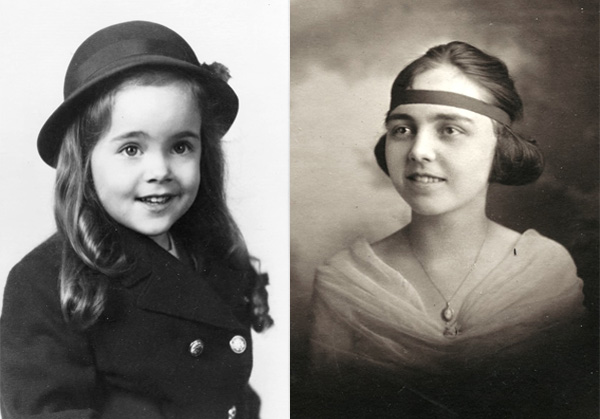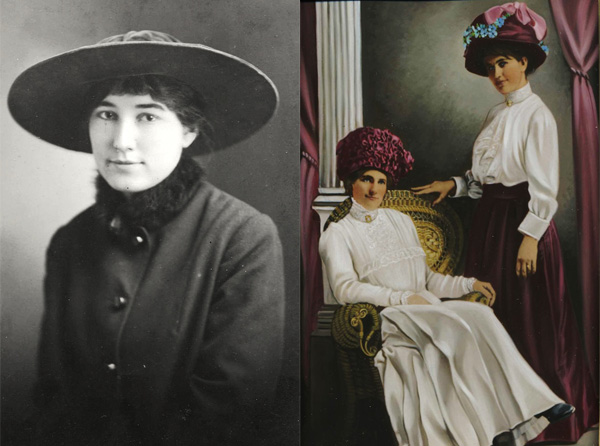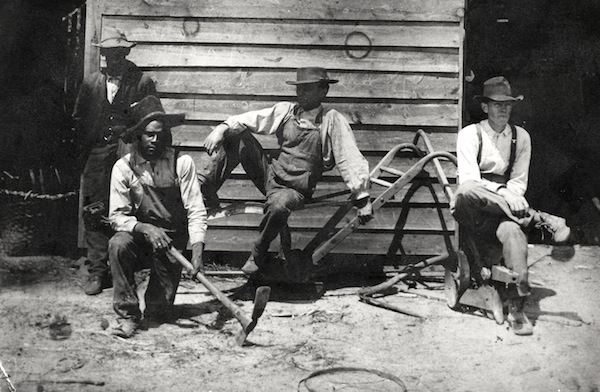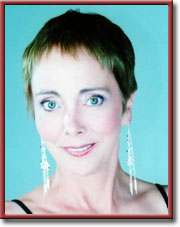My Aunts George, Johnnie & Bill (& The Hat in My Attic)
Ruminant With A View
“That I have such a hat at all—some three feet in diameter, made of fine Carludovica palmate, bordered in iridescent mint ribbon and festooned with ashes-of-lilac flowers—necessitated first having ‘the idea of the hat,’ and that idea was planted in, and on, my head in childhood.”—Elizabeth Boleman-Herring
By Elizabeth Boleman-Herring

BRIDGE & TUNNEL New Jersey—(Weekly Hubris)—5/5/2014—In our New Jersey attic, there is precisely one hat, standing in immense and ghostly isolation beneath a tent of blue Indian gauze, its custom-made hat-stand crafted by a friend in Up-Country South Carolina about 20 years ago.
The hat itself was made in England, by Anne Karol, and purchased for me from a “ladies’” shop, Village Fashions, which occupied a place of honor on Pendleton, South Carolina’s town square from 1979 till 2000, and was run by my neighbors, Pat and Harry Evans. Many of us who taught at Clemson University in the 1990s favored conservative, floral dresses and monochrome “outfits” purchased from Village Fashions. The hat, though floral in theme, is anything but “conservative.”
I wore it only once in public, to the wedding of a fellow Clemson professor, and the seemingly unlikely beau with whom she fell in love at a Western dude ranch, married, and has lived with happily ever after since. Only in the 90s could one (I) still pull off wearing a hat as large, and as daft, to a high-summer wedding in small-town, Presbyterian America. Of course, the British, and certain “church ladies” still wear such hats left, right, and center, but mine will probably now be consigned to the attic, wherever my husband and I live (though I may be mistaken: in my 70s or 80s, perhaps I will once again throw caution to the winds).
That I have such a hat at all—some three feet in diameter, made of fine Carludovica palmate, bordered in iridescent mint ribbon and festooned with ashes-of-lilac flowers—necessitated first having “the idea of the hat,” and that idea was planted in, and on, my head in childhood.
My mother wore hats from her own girlhood in Townville, South Carolina and on, till the very end of her life. She wore hats everywhere. In 1950s Los Angeles, in the circles in which my mother and her friends moved, and in the California sunshine, hats were a necessity, as well as a complex statement as old as the images of pale-faced Egyptian royalty; as were gloves, and other clothing meant to preserve a woman’s skin from aging. My, how we have changed; and changed again, since those years.
The hats of the 1950s, and of the upper middle class in general on America’s West Coast, were very different from the hats of 1930s and 40s South Carolina, however. My mother’s California hats were small and sleek, for the most part, and featured veils. In her shadow, out there in the sun, I myself wore (and was photographed in) small straw boaters ringed with bright flowers, a navy bowler trimmed with red cherries, and a sailor’s cap (for all athletic events at Pasadena Country Day School). Even children habitually wore hats (and the girls, white gloves) in my childhood, though only for church and “dress-up.” At play, we gave ourselves over to the sun, and everyone went shirtless till age five.
Given my early years out West, which I have compared elsewhere to the rarefied childhood of the little Buddha, I could not imagine the threadbare poverty out of which my elegant mother had emerged, and from which she had fled, in Depression-era Carolina.
We flew back to the South rarely, picked up at the airport in Atlanta by my mother’s sister, Inez, who lived with her husband, my Uncle Clay, and their two sons, my cousins, Randy and Larry, in Spartanburg, not really too far from where my maternal grandparents lived, all their lives, in tiny, rural Townville.

I never remember spending a night in Townville over the course of those brief visits. Instead, we stayed either in Spartanburg, with Aunt Inez, or in Seneca, with Aunt Bill.
Aunt Bill. I think I must not be alone among Southern women of a certain age in having three women relatives known by men’s names, and this was not a matter of the British ambiguity of “Shirley” or “Leslie” or “Evelyn.” This was a matter of fierce choice on the part of all three of my aunts: Great Aunt Johnnie, the wife of a mule-trader, who was a “Correspondent” (read: gossip columnist) for the Seneca Journal; Aunt Bill, my mother’s eldest sister, originally named Willie Sue, as family legend has it, after one of her father’s old flames; and my great-aunt-by-marriage, and Inez’s mother-in-law, George.
Bill was, I believe, damned if she was going to go by a name such as “Willie Sue,” and we nieces and nephews always called her “Aunt Bill” or, more usually, just “Bill.”
My pro-golfer and retired physics professor cousin Randy is currently home recovering from a triple-laminectomy and, so, barred from the greens for a while, during which time he has proven willing to chat by phone and at length with female relatives.
So, I asked him, last week, how George came to be called George.
“Well, my Grandfather Pleas—that would be Pleasant Mahaffey—was a great kidder,” said my cousin, my elder by 15 years, who knows a lot more than I about our extended family’s life-before-my time in Townville, before the advent of our relative prosperity.
“I was about ten years old, in around 1946,” said Randy, “when Pleas took me aside and told me, ‘Go over there and call your Grandmother Alice ‘George’ . . . and see what she does.”
Apparently, someone named George had been an early beau of Alice’s, and Pleas was prepared to enjoy putting the needle in his wife via their grandson. What he didn’t bank on was Alice’s reaction.
“She adopted the name right there and then,” said Randy, “and was never known as anything else but ‘George.’”
Southern women: you do not want to mess with us, with or without hats.
When I came to know George, she and Aunt Johnnie, both of whom were born in the late 19th century, and never truly entered the 20th, rarely emerged from their darkened sitting rooms, except to attend church. Aunt Johnnie, who lived next door to her niece, Aunt Bill, in Seneca, was a stout, powerful woman who had great trouble releasing a tiny grand-niece from her floral embrace. I was made to call upon her, but could never wait to get away.
Aunt George I never saw out-of-doors, but visited, briefly, in her bare, pot-bellied-stove-heated dining room in Townville, where she sat adjacent her African-American companion of many decades, Mariah, in companionable silence. Mariah would be the only Black guest at my 1972 wedding, which was held in a tiny Episcopal church in Seneca. I visited Mariah regularly, but was a bit intimidated by George who, by the time I knew her, was silent, shapeless, long, long a widow, and worn out by time and hard work. I would give anything now to know more about her.
It was truly by chance, after her death, that I was sent, by my mother and her sister, to the two big houses in Townville—those of the Bolemans and the Mahaffeys—in order to see if any family treasures were being left behind in the crumbling Victorian homes about to be sold.
On an upper story in George’s house, I came upon a flock of immense church hats, displayed, under paper drapes, on beds, chairs, and dressers.
I remember being alone in the room at the time, wondering how and when Aunt George, she of the severely cropped white hair and featureless face, might have worn these confections.
This past week, I learned from my cousin that the hats were not George’s at all, but had belonged to, and been abandoned by, a couple or a maiden lady renting the top-floor bedrooms. Lodgers. In Townville. It was something I could not have imagined.
Randy also told me that George had, at one point, both churned butter for neighbors, preparing pats for sale, and collected hens’ eggs to sell in little baskets.
George must have been laboring, in her 60s and 70s, just a floor below the congregation of fanciful hats in her lodgers’ upstairs rooms.
My early years in California were so privileged as to have been like something out of a dream, and my mother kept Townville’s realities and privations a secret from me until she and my father returned to the South for good in the late 1960s. She was unhappy about the move, and I now understand so much better why it distressed her.
Looking back from this vantage, I see what an island of illusion the 1950s, 60s and 70s were for America’s post-war middle class. So many had escaped—by an inch—so very much, and they imagined, back then, that they, and their children, had escaped for good. Those who had fought in World War II, or who, like my father, had survived tuberculosis just before the advent of antibiotics, wanted nothing so much as to forget the war and the Depression that preceded it.
My parents’ generation may have been the last to imagine that life would, in fact, become better and better; that humanity would wax ever more enlightened, and that justice and wisdom would prevail. Theirs was the mythology that colored my early ideas of the world, and of the future.
Now, I see human history as one of small and larger cycles. The optimism of the 50s would not last; the middle class, as I knew it early on, would be brought to its knees; the Millennials are now fortunate to be “lodgers” in their own parents’ houses, or to have jobs of any sort to look forward to.
And I ponder the beautiful, fey hat in my attic, and the beautiful hats left behind, and sold with the Mahaffey house (and then, presumably, tossed out by the new buyers).
In the least of our possessions such history resides, especially if the women of a family—who are the traditional stewards of history—will treasure and explicate and repeat it.


Note: My cousin Clay Randolph Mahaffey, a former physics and astronomy professor retired from Wofford College, has many details to add to our family story:
“In the 1930s and 40s, Townville was a community comprising only some 200 to 300 people. It was a farming community, with cotton being the primary crop. All the families raised their own food and used the canning facility near the high school to can their produce. They had cows, mules, chickens, hogs, and beef cattle which they also used to feed their families. The idea of raising one’s own food was especially important, even to so-called “city folks,” what Townville’s residents called my Spartanburg family and, even in town, we had a victory garden during the war years. The pleasure one gets from raising crops has stuck with me, as I really enjoy planting a garden every year.
“Both of my grandfathers owned general merchandise stores in Townville, with a cotton gin separating the two. Both men were well-known in Townville for being land owners and successful business men. Their families’ lives centered upon the local Baptist church, where they both served in leadership positions. Both my maternal grandparents received an award for 50 years of perfect attendance at Townville Baptist, a record that is hard to believe today.
“Papa Boleman’s store was a popular spot on Saturday night because, upstairs, was a large room that was used for square dancing. His nick name was “Rocky,” after John D. Rockefeller, because he owned the first car in Townville, a large Packard.
“As I said, cotton was the money crop in Townville. I remember picking cotton all day on a Saturday and thinking I would get rich from all that work: I made 93 cents.
“My paternal grandmother, George Mahaffey , who died in 1970, was a beautiful lady who came to Townville from Sherman, Texas as a bride. She was a widow for 22 years and, during those years, she continued to play an active role in her community. Even in old age, George was a dignified lady with a compassionate, loving face; and always a twinkle in her eyes. In her later years, she became completely blind and sat in a wheel-chair after suffering a broken hip. However, she never lost her smile and her interest in her family and community.
“I remember a sweet story about the first time she held our son Clay in her arms. When we commented that Clay had blue eyes instead of the family’s brown eyes, she said: ‘Well, I guess when he was being born, as he came down from heaven, he got some of the sky in his eyes.’
George was a woman rich in character, in reputation, and in dignity. She died at age 89. We never thought of George as being poor: she was a woman who shared her life and her possessions with others, and was rich in so many ways. She taught Sunday school for years and opened her home to several people who needed a place to live. At one time, she rented out rooms to local school teachers who needed a respectable address.
“The story that best illustrates my grandparent’s compassion and love for others centers around an African-American ten-year-old named John Sloan. After John’s parents and grandmother died, John came to George’s home and asked if he could spend the night with them. John was a favorite playmate of my father. They spent lots of time hunting, fishing, and playing baseball together. George and Pleas did not hesitate to take John in that night. In fact, John lived with them until he was 21, was treated as a son by both Pleas and George, and tutored by my grandmother.
“My grandparents were determined that the child not be sent to an orphanage, so they adopted him. After John graduated from high school, he moved to Greensboro, NC, and worked for over 50 years at the YWCA. He named his two sons Randy and Larry, after my brother and me.
“My grandfather died in 1948, and a woman named Mariah Holland, who had helped my grandmother in many ways during their lives, moved in with her. Mariah was considered part of the family, and she felt that same way towards us. Mariah remained in my grandmother’s house for about ten years after my grandmother died. When the house was finally sold, Mariah moved back to her original home, where she lived with her daughter. My dad traveled to Anderson, SC, the county seat, to make sure that Mariah would receive Social Security.
“My heritage, and my grandparents in Townville, have left me with a love for the land and labor, and an appreciation for members of a former generation of Up-Country South Carolinians who worked hard and lived lives of quiet honor.”



One Comment
Dean Pratt
Really enjoyed the history lesson from you both! So much has changed since those days and the humanity and spirit of the people are harder to find now, but they are here and we must treasure their lives when we meet them. Would loved to have met the three wise woman, Bill, Johnnie and George.